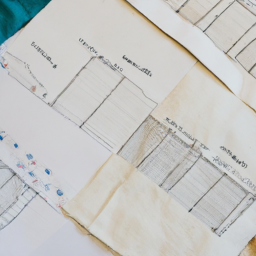

Learning to sew patterns can be an exciting journey for beginners. Whether you want to create your own clothes
or simply enjoy the art of sewing, understanding patterns is essential. This article will guide you through the
basic steps to get started with sewing patterns.
Step 1: Select a Pattern

Begin by choosing a pattern that matches your skill level. Look for patterns labeled “beginner” or
“easy-to-follow.” This will help you grasp the fundamental techniques required for successful sewing. Consider
selecting a pattern for a basic skirt, pillowcase, or tote bag as they are great beginner projects.
Step 2: Gather Required Materials

Next, gather all the necessary materials mentioned in the pattern instructions. This usually includes fabric,
matching thread, buttons, zippers, and any other notions required to complete the project. Ensure you have all
the tools and supplies handy before you begin sewing.
Step 3: Prepare the Fabric

Before cutting the fabric, pre-wash it to prevent shrinking later on. Iron out any wrinkles and lay the fabric
flat on your cutting surface. Use fabric scissors to carefully cut the pattern pieces following the guidelines
provided in the pattern instructions. Take your time and be precise, as accurate cutting is crucial for a
well-fitted garment.
Step 4: Pin and Cut Pattern Pieces

Pin the pattern pieces to the fabric according to the instructions provided. Use sewing pins to secure the
pattern, ensuring it doesn’t shift while cutting. Take your fabric scissors and cut along the pattern lines,
removing the pins as you go. Remember to cut notches or mark any important points for easier assembly later.
Step 5: Sewing the Pattern
- With right sides together, align the fabric pieces as indicated in the pattern instructions.
- Using a sewing machine or hand sewing methods, sew along the designated seams, following the provided stitch
length and width guidelines. - Backstitch at the beginning and end of each seam to secure the stitches.
- Press open the seams using an iron to give the finished garment a polished look.
- Continue following the pattern instructions for assembling and finishing the project.
Step 6: Practice and Experiment

As a beginner, don’t be afraid to make mistakes. Sewing is a skill that improves with practice. Start with simple
patterns and gradually move on to more complex designs. Experiment with different fabrics, colors, and trims to
unleash your creativity and build confidence in your sewing abilities.
Conclusion
Sewing patterns might seem overwhelming at first, but with patience and practice, you’ll become confident in
designing and sewing your own garments. Remember to start with beginner-friendly patterns, gather all necessary
materials, prepare and cut the fabric accurately, and follow the pattern instructions carefully. Sewing is both a
practical and creative skill that brings satisfaction and joy. So, grab your sewing machine, pick a pattern, and
embark on this exciting sewing journey!
Happy sewing!